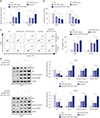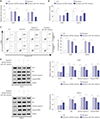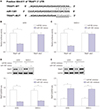Abstract
Purpose
Materials and Methods
Results
Figures and Tables
Fig. 1
Effects of epirubicin on proliferation and apoptosis in osteosarcoma cells. (A) Osteosarcoma cell lines U2OS and SAOS-2 were treated with different concentrations of epirubicin for 48 h, and Cell Counting Kit-8 assay was performed to evaluate cell proliferation. (B) U2OS and SAOS-2 cells were exposed to 0 µg/mL or 1 µg/mL of epirubicin for 48 h, respectively. Flow cytometry was introduced to determine cell apoptotic rate. (C) Western blot was conducted to examine the expressions of Bcl-2, Bax, cleaved-caspase-3, and cleaved-poly (ADP-ribose) polymerase-1 (cleaved-PARP1) in U2OS and SAOS-2 cells with 48 h of 0 µg/mL or 1 µg/mL epirubicin exposure. *p<0.05. Bcl-2, B-cell lymphoma-2; Bax, Bcl-2 assaciated X protein; GAPDH, glyceraldehyde-3-phosphate dehydrogenase.

Fig. 2
Epirubicin stimulates the expression of microRNA-1301 (miR-1301) in U2OS and SAOS-2 cells. (A) qRT-PCR was employed to measure the expression of miR-1301 in human osteoblast cells hFOB1.19, U2OS cells, and SAOS-2 cells. (B) The expression of miR-1301 in U2OS or SAOS-2 cells treated with 1 µg/mL of epirubicin for 24 h or 48 h. *p<0.05. qRT-PCR, quantitative real-time polymerase chain reaction.

Fig. 3
Upregulation of microRNA-1301 (miR-1301) contributes to the anti-cancer effect of epirubicin in osteosarcoma. U2OS and SAOS-2 cells were transfected with miR-NC mimics or miR-1301 mimics, and after 24-h transfection, cells were treated with epirubicin (1 µg/mL) for 48 h. Cells were divided into five groups: Ctrl, miR-NC mimics, miR-1301 mimics, Epirubicin, or Epirubicin+miR-1301 mimics. (A) qRT-PCR was introduced to detect the levels of miR-1301. (B) Cell Counting Kit-8 was applied to analyze cell proliferation in U2OS and SAOS-2 cells. (C) Flow cytometry was utilized to evaluate cell apoptotic rate. (D) The expressions of Bcl-2, Bax, cleaved-caspase-3, and cleaved-poly (ADP-ribose) polymerase-1 (cleaved-PARP1) in U2OS and SAOS-2 cells were measured using Western blot. The + respensents Epirubicin or mimic was used to treat cells, while the meaning of - was opposite with +. *p<0.05. Bcl-2, B-cell lymphoma-2; Bax, Bcl-2 assaciated X protein; GAPDH, glyceraldehyde-3-phosphate dehydrogenase.

Fig. 4
MicroRNA-1301 (MiR-1301) depletion weakens the anti-cancer effect of epirubicin in osteosarcoma. U2OS and SAOS-2 cells were transfected with miR-NC inhibitors or miR-1301 inhibitors, and after 24-h transfection, cells were treated with epirubicin (1 µg/mL) for 48 h. Cells were divided into four groups: Ctrl, Epirubicin, Epirubicin+miR-NC inhibitors, or Epirubicin+miR-1301 inhibitors. (A) The expression levels of miR-1301 in cells were determined using qRT-PCR. (B) Cell proliferation was measured in U2OS and SAOS-2 cells. (C) Flow cytometry was utilized to analyze the cell apoptotic rate. (D) Western blot was employed to examine the expressions of Bcl-2, Bax, cleaved-caspase-3, and polymerases (PARP1) in U2OS and SAOS-2 cells. The + respensents Epirubicin or mimic was used to treat cells, while the meaning of - was opposite with +. *p<0.05. Bcl-2, B-cell lymphoma-2; Bax, Bcl-2 assaciated X protein; GAPDH, glyceraldehyde-3-phosphate dehydrogenase.

Fig. 5
TP53-regulated inhibitor of apoptosis 1 (TRIAP1) is a target of microRNA-1301 (miR-1301). (A) The binding sites between miR-1301 and TRIAP1 were predicted by the TargetScan online database, and luciferase reporter plasmids containing the wild-type (WT) or mutated (MUT) TRIAPT1 binding sites of miR-1301 were established. (B) The luciferase activity was measured in U2OS cells co-transfected with TRIAP1-WT or TRIAP1-MUT luciferase reporter plasmids and miR-1301 mimics or miR-NC mimics. (C) The luciferase activity was examined in SAOS-2 cells co-transfected with TRIAP1-WT or TRIAP1-MUT luciferase reporter plasmids and miR-1301 mimics or miR-NC mimics. (D) The expression of TRIAPT in U2OS and SAOS-2 cells transfected with miR-1301 mimics or miR-NC mimics. (E) The expression of TRIAP1 in U2OS and SAOS-2 cells transfected with miR-1301 inhibitors or miR-NC inhibitors. (D and E) The + respensents Epirubicin or mimic was used to treat cells, while the meaning of − was opposite with +. *p<0.05. GAPDH, glyceraldehyde-3-phosphate dehydrogenase.

Fig. 6
Epirubicin regulates TP53-regulated inhibitor of apoptosis 1 (TRIAP1) expression by modulating microRNA-1301 (miR-1301). (A-C) U2OS and SAOS-2 cells were transfected with miR-NC inhibitors or miR-1301 inhibitors, and after 24-h transfection, cells were treated with epirubicin (1 µg/mL) for 48 h. Cells were divided into four groups: Ctrl, Epirubicin, Epirubicin+miR-NC inhibitors, or Epirubicin+miR-1301 inhibitors. (D-G) U2OS and SAOS-2 cells were transfected with vector or TRIAP1 overexpression plasmid (TRIAP1), and after 24-h transfection, cells were treated with epirubicin (1 µg/mL) for 48 h. Cells were divided into four groups: Ctrl, Epirubicin, Epirubicin+vector, or Epirubicin+TRIAP1. The mRNA levels of TRIAP1 in U2OS and SAOS-2 cells were evaluated (A and D). Western blot was applied to examine the levels of TRIAP1 in U2OS (B and E) and SAOS-2 cells (C and F). (G) Cell viability was determined by Cell Counting Kit-8 assay. (B, C, E, and F) The + respensents Epirubicin or mimic was used to treat cells, while the meaning of - was opposite with +. *p<0.05. GAPDH, glyceraldehyde-3-phosphate dehydrogenase.

Notes
AUTHOR CONTRIBUTIONS
Conceptualization: Lijun Yu and Min Meng.
Data curation: Min Meng and Yun Bao.
Formal analysis: Chao Zhang.
Funding acquisition: Bei Gao and Rina Sa.
Investigation: Wenyuan Luo and Lijun Yu.
Methodology: Lijun Yu and Bei Gao.
Project administration: Rina Sa and Lijun Yu.
Resources: Wenyuan Luo.
Software: Wenyuan Luo.
Supervision: Bei Gao.
Validation: Yun Bao.
Visualization: Min Meng.
Writing—original draft: Bei Gao and Lijun Yu.
Writing—review & editing: Lijun Yu and Yun Bao.




 PDF
PDF ePub
ePub Citation
Citation Print
Print



 XML Download
XML Download